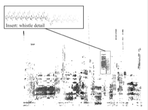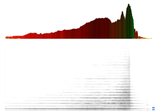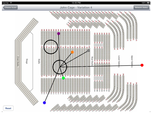Mobilising John Cage – The design and creation of score generators for the complete John Cage Variations I – VIII.
| ||||||||||||||||||||
| mmj201322.pdf | |
| File Size: | 2224 kb |
| File Type: | |
The Limitations of Representing Sound and Notation on Screen
Lindsay Vickery, School of Music, Western Australian Academy of Performing Arts .
Organised Sound 19(3)

Animated screen-based representation and notation provides an important solution to visualising a range of musical phenomena and techniques including continuous parametrical changes, synchronisation with prerecorded audio or live processing, and nonlinear formal organisation. The limitations of human visual capabilities, however, place some constraints upon the efficacy of screen-based representation, particularly in regard to notation reading. Findings from sightreading studies, exploring the manner in which notation is encoded, processed and executed, are examined with the aim of identifying the perceptual and practical boundaries of presenting animated notation on screen. The development of efficient notation is proposed as an important requirement for alleviating the issues created by the time constraints of notation reading. Studies in semantics and cross-modal activation are discussed as a foundation for the expansion of approaches to the visualisation of sound.
Exploring a Visual/Sonic Representational Continuum
Lindsay Vickery, School of Music, Western Australian Academy of Performing Arts.
International Computer Music Conference, Athens, Greece.

This paper explores the relationships between sound and its visualisation, focussing upon the issues surrounding representation and interpretation of music through both performative and machine processes. The discussion proceeds in the context of five recent works by the author exploring the representation of sound and musical notation and their relationship to and with performance: unhörbares wird hörbar (the inaudible becomes audible) [2013], EVP [2012], Lyrebird: environment player [2014], Nature Forms I [2014] and sacrificial zones [2014]. Issues examined include: re-sonification of spectrograms, visualisation of spectral analysis data, control of spatialisation and audio processing using spectral analysis data, and reading issues related to scrolling screen score notation.
| icmc2014vickeryws.pdf | |
| File Size: | 3913 kb |
| File Type: | |
| vickeryicmcposter.pdf | |
| File Size: | 3617 kb |
| File Type: | |
Notational Semantics in Music Visualisation and Notation
| ||||||||||||||||||||
| acmc2014vickery.pdf | |
| File Size: | 2298 kb |
| File Type: | |
Notating the Sonic Environment
Lindsay Vickery, School of Music,
Western Australian Academy of Performing Arts
Electroacoustic Music Studies Network Conference, Berlin 10-14 June 2014

Emulation of the sounds of the natural environment may be one of the earliest manifestations of music. Alvin Lucier’s (Hartford) Memory Space (1970) and Carbon Copies (1989) both explore this impulse, instructing performers to imitate the sounds of any indoor or outdoor environment (albeit pre-recorded), “as exactly as possible, without embellishment” (Lucier, A. 1989. Carbon Copies. Material Press: Frankfurt am Main). This final clause may have been necessary because the complexity of natural sonic environments often prohibits exact imitation and encourages embellishment.
This paper describes a scoreplayer implemented in MaxMSP, that analyses and visualises significant features of a sonic environment as a graphic score, that is scrolled from right to left across the computer screen. Playback of the source recording is delayed so that it is heard as the corresponding visual event arrives at the “playhead”: a black line of the left of the screen.
This paper describes a scoreplayer implemented in MaxMSP, that analyses and visualises significant features of a sonic environment as a graphic score, that is scrolled from right to left across the computer screen. Playback of the source recording is delayed so that it is heard as the corresponding visual event arrives at the “playhead”: a black line of the left of the screen.
| notatingthesonicenvironment.pdf | |
| File Size: | 1676 kb |
| File Type: | |
Improvising with the Sonic Environment
Lindsay Vickery, School of Music, Western Australian Academy of Performing Arts
Vs Representation, Prague 17-20 July 2014

The “Lyrebird Environment Player” builds upon Vickery’s earlier work EVP, in which “electronic voice phenomenon” recordings were visualised as a scrolling score in realtime. In the current work the performer may also choose to analyse the field recording to detect recorded speech or speech-like artifacts that may be present. These are represented in the score as standard text that is visualized using the frequency, amplitude, brightness, noisiness and bark scale values that are applied to non-speech sounds.
The work was commissioned by percussionist Vanessa Tomlinson for her Australian solo percussion program Eight Hits. The proposed performance practice for the work was developed by the authors during Tomlinson’s residency at the Orpheus Instituut for Advanced Studies & Research In Music. It requires that Tomlinson make a field recording and collect objects to play in the vicinity of each new performance venue. Familiarity with the recording and strategies for improvising with it may be developed subsequent to its performance.
The work was commissioned by percussionist Vanessa Tomlinson for her Australian solo percussion program Eight Hits. The proposed performance practice for the work was developed by the authors during Tomlinson’s residency at the Orpheus Instituut for Advanced Studies & Research In Music. It requires that Tomlinson make a field recording and collect objects to play in the vicinity of each new performance venue. Familiarity with the recording and strategies for improvising with it may be developed subsequent to its performance.
| improvisingwiththesonicenvironment.pdf | |
| File Size: | 1698 kb |
| File Type: | |
Representing Sound with Colour in Music Notation
|
Research at The Visual Perception and Aesthetics Lab at the University of California Berkeley since 2012, suggests that there is a high degree of correlation between mappings of colour-to-sound: that there are systematic relationships between colour and a range of musical phenomena including timbre, pitch, tempo, intervals, triads and musical genres in non-synaesthetes. This phenomenon, in which cross-modal activation is present in the population at large, has been described by Martino and Marks as “weak synaesthesia”.
This paper explores the implications of recent research into colour-to-sound mappings for the application of colour in musical scores with a particular focus on the representation of timbre segmentation for instruments and electronically generated sound as a tool for creating “semantically sound” scores and for the analysis of sound recordings.
| ||||||




